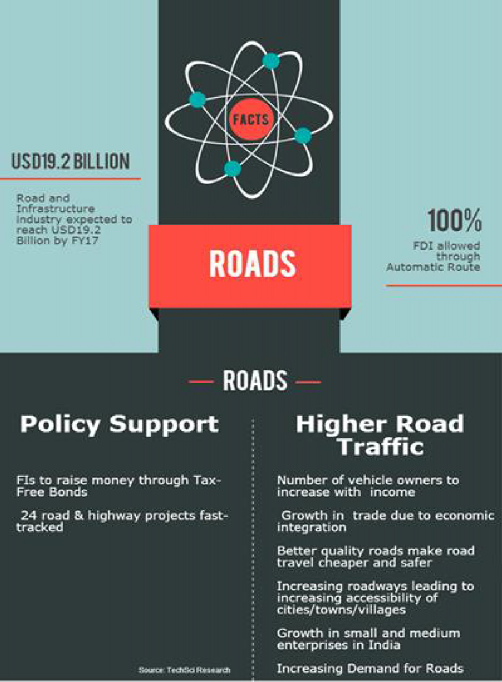3. Roads and Road Transport

National Highways, which are the responsibility of the Central Government, account for around 2 per cent of the total road network in India and had total length of 1,15,435 Km in June 2017. National Highways carry around 40% of the total traffic across the length and breadth of the country.
The development of the roads got a big boost with the launching of a seven-phase programme
- NHDP (National Highways Development Project), vested with National Highways Authority of India (NHAI), for the development of National Highways in the country and PMGSY (Pradhan Mantri Gram Sadak Yojana). NHDP aimed at primarily strengthening and widening the high density corridors of NHs. On the other hand the PMGSY was designed to improve the accessibility of habitations in the rural areas.

Indian Road Congress is a semi-official body setup by
government in 1934 on the recommendations of the Jaykar Committee. It is the apex body in the country for road engineers and regularly updates the requirements such as width, sight distance etc.
Until 2010, National Highways were numbered according to the National Highways Act of 1956.
Post 2010, east-west highways have odd numbers while north-south highways have even numbers.
Only the central government has the authority to classify any stretch of road as National Highway.
The National Highways Authority of India, created as per the National Highways Authority Act, 1988 is responsible for the upkeep of National Highways.
The PWD departments of respective states are responsible to look after state highways.
♤
♤
♤
♤
♤
Road Classification in India
♤ The Indian Road Congress classifies Indian Roads into 5 categories:
o National Highways
o State Highways
o Major District Roads
o Other District Roads
o Village Roads
♤
The private sector has emerged as a key player in the development of road infrastructure in India. Increased industrial activities, along with increasing number of two and four wheelers have supported the growth in the road transport infrastructure projects. The government’s policy to increase private sector participation has proved to be a boon for the infrastructure industry with a large number of private players entering the business through the public- private partnership (PPP) model. Recently, the Government has launched Bharatmala Pariyojana which is expected to provide NH linkage to 550 districts, and be a major driver for economic growth in the country.
Also, the Government has permitted
100 per cent foreign direct
investment (FDI) in the road sector, thus facilitating several foreign companies in entering into partnerships with Indian players to capitalise on the sector's growth.
